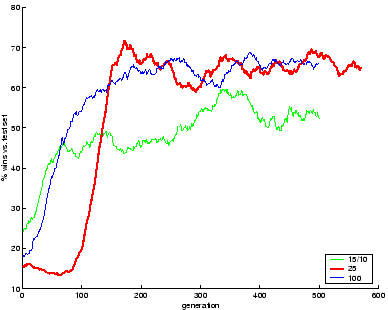


Next: Tuning up the Novelty
Up: Evolving Agents Without Human
Previous: Experimental Setup
The graph on fig. 3.23 summarizes our findings. Three groups were
evolved for 500 generations each: group A with a training set of 25 agents replaced
on every generation (as per formula 3.3 on page ![[*]](./cross_ref_motif.gif) );
group B with a larger training set size of 100; and group C with identical settings
as the novelty engine: a training set of 25 out of which just 10 are replaced
on every generation whereas the remaining 15 remain fixed throughout the experiment,
being the 15 best against humans as per equation 3.1.
);
group B with a larger training set size of 100; and group C with identical settings
as the novelty engine: a training set of 25 out of which just 10 are replaced
on every generation whereas the remaining 15 remain fixed throughout the experiment,
being the 15 best against humans as per equation 3.1.
Figure 3.23:
Control Experiments. Agents
were evolved for 500 generations, using self play alone. The performance measure
is a set of 90 champions-vs-people (survivors at generation 240). Three different
configurations are shown: A with training set size t=25 and full
replacement (f=0 (thick line); B with t=100 and
f=0 (black line) and C with f=15 and t=25,
so 15 out of 25 members of the training set are fixed (grey line). The latter
is the configuration originally used by the novelty engine, which was shown
here to be suboptimal with respect to the others. This result suggested changing
the setup of the novelty engine to the current setting of f=1.
|

|
The results showed group C, with similar setup as the novelty engine, approaching
an average 50% score after one or two hundred generations. This is the expected
result, since the setup reproduces exactly the conditions over which the evaluation
group was produced.
But groups A and B unexpectedly performed much better. Both peak at at
performance of 65% percent, which means that they are consistently better than
the evaluation set. This finding supports previous results by Angeline and Pollack
[4] with Tic-Tac-Toe: evolving against fixed experts
is outperformed by coevolution. In the Tron domain, evolving specialists is
a bad idea: they will learn subtle maneuvers that work specifically with the
prefixed opponents; but the environment of a changing training set, a moving
target, is much broader. In other words, the changing, adaptive nature of a
training set replaced with every generation, produces a diverse landscape that
results in the evolution of robust solutions.
It was also surprising to observe that there was not much difference with the
increased size of the training set on group B. This second group climbs the
initial learning ladder in less generations -- hitting 50% after 80 generations,
as compared with 140 generations for group A. The latter is more efficient,
however, given the fact that the number of games played per generation is quadrupled
for group B. Both groups settle after reaching a 65% performance, and there
was no apparent benefit from choosing a larger training set size.



Next: Tuning up the Novelty
Up: Evolving Agents Without Human
Previous: Experimental Setup
Pablo Funes
2001-05-08
![[*]](./cross_ref_motif.gif) );
group B with a larger training set size of 100; and group C with identical settings
as the novelty engine: a training set of 25 out of which just 10 are replaced
on every generation whereas the remaining 15 remain fixed throughout the experiment,
being the 15 best against humans as per equation 3.1.
);
group B with a larger training set size of 100; and group C with identical settings
as the novelty engine: a training set of 25 out of which just 10 are replaced
on every generation whereas the remaining 15 remain fixed throughout the experiment,
being the 15 best against humans as per equation 3.1.
